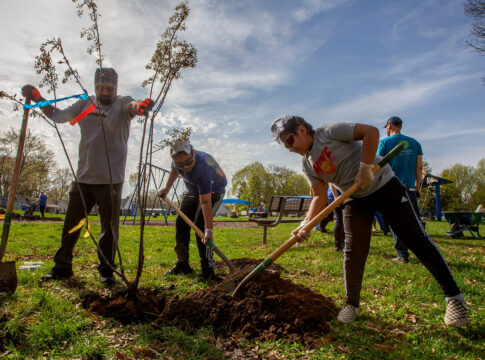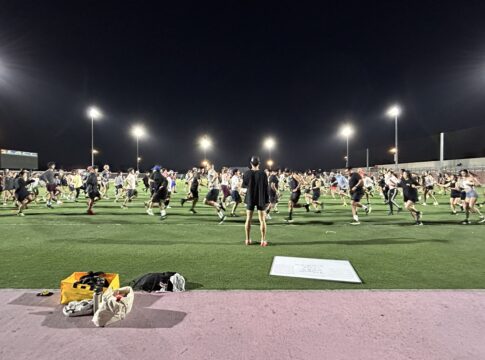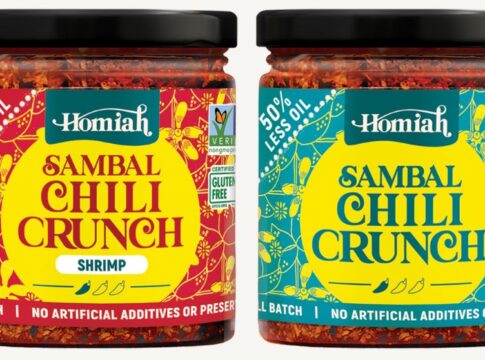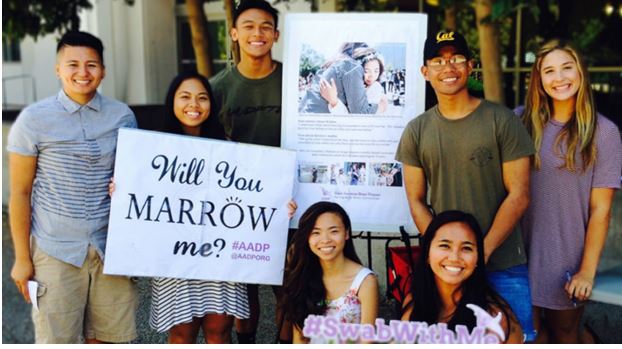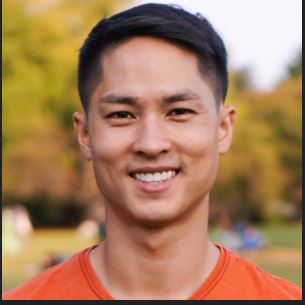By Karin Jensen
Asian American Donor Program (AADP) is excited to return to a regular schedule of in-person stem cell donor registration drives. The work they do saves the lives of those without other options, those with diseases of the blood and bone marrow. Unfortunately, during the pandemic, they had to rely almost entirely on mail-in registrations.
AADP works to increase the availability of potential stem cell donors for patients with life-threatening diseases curable by a stem cell transplant. They specialize in donor registration drives in Asian American communities of Northern California and accept mail-in registrations from anywhere in the country. They are an official recruitment center of the Be The Match registry, which connects patients searching for a cure with life-saving bone marrow donors.
Carol Gillespie, Executive Director of AADP, describes how the pandemic crippled the nonprofit. “In March 2020, our annual fundraiser, Laugh for Lives, was canceled because of the stay-at-home order. We usually have 800 people attend this event, so this was quite a loss.
“Since then, the AADP team has been working from home with reduced hours and few online presentations. All of the venues we would generally work with to do donor drives – colleges, places of worship, and corporations were all trying to pivot to a new reality. Any additional stress or asks of them were not well received. We recruited very few donors for six months.
LATEST STORIES
“Then, in October 2020, AJ, a Filipino-American baby boy, was diagnosed with leukemia and lymphoma and needed a marrow donor. We started working on his campaign and received a massive response from the Filipino-American community and many others.
“Eleven thousand people requested a home registration kit, and about 3500 were able to register. Many weren’t able to register because they weren’t qualified, but they all tried!”
Sadly, even with this great response, AJ did not find a match in time and passed away at 17 months old. However, his parents, Eric and Maria, proudly noted, “AJ’s lasting impact to the world was the huge number of volunteers that registered to be bone marrow donors after hearing about him.”
Who Needs a Bone Marrow Transplant?
Every year, more than 18,000 Americans are diagnosed with life-threatening blood cancers — like leukemia and lymphoma, and 70 other diseases for which a marrow, blood stem cell, or umbilical cord blood transplant may be their best or only hope of a cure.
Healthy marrow and stem cells are needed to live. When a disease affects the bone marrow so that it can’t function properly, then the blood also becomes diseased. Cures become complicated. For instance, chemotherapy can cause remission of bone marrow disease. At the same time, it destroys the immune system. For the patient to recover, they need entirely fresh, healthy bone marrow from a donor so they can rebuild a brand new immune system.
Unfortunately, finding a donor is formidable. For a successful transplant, a patient needs a matching donor. Seventy percent (70%) of patients cannot find a matching donor within their family. These patients depend on the Be The Match Registry.
Race and Ethnicity Matter
Because the markers used in matching are inherited, patients are more likely to match someone from their race or ethnicity. Adding more bone marrow and umbilical cord donors from diverse racial and ethnic backgrounds to the Be The Match Registry increases the likelihood that patients will find the match they need.
Your heritage can make all the difference. If you are from one of the following communities, you are especially encouraged to register as a bone marrow donor or donate umbilical cord blood upon delivery:
- Black and African American
- American Indian and Alaska Native
- Asian (which includes East, Southeast & South Asians)
- Native Hawaiian and other Pacific Islander
- Hispanic and Latinx
- Multiple races
The statistics are stark:
Asian American Donor Program
In sum, far fewer potential donors from minority communities have registered. However, regardless of which community you belong to, you are encouraged to sign up if you are willing to save a life.
What’s Involved
To be a donor, you must be 18 to 44 years old and in generally good health. Donors in the 18-35 age group are particularly precious because research shows cells from younger donors lead to more successful transplants.
To register, you can request a Home Kit. Completing the contents of the Home Kit takes five minutes. You fill in a form, swab the inside of your check, and mail the kit back in the postage-paid envelope.
The swab goes to a lab that identifies your markers and adds your record to the Be The Match Registry. Physicians around the world search this Registry. You may never be contacted, but if you are, you have the option to donate or not.
If you are contacted and choose to donate, collecting marrow or peripheral blood stem cells takes about a day and is usually done near home.
Some facts about donating:
- Doctors take liquid marrow from the back of the hip bone using a syringe. Donors are given anesthesia and feel no pain during the donation. When they wake up, they will feel sore in the local area. This procedure is done less than 20% of the time.
- The other 80% of the time, stem cells are harvested. The donor receives an injection of filgrastim for five days to stimulate production of marrow stem cells which release into the bloodstream. On the 5th day, the donor goes into the collection center, where needles are placed in both arms. Blood is drawn from one arm and goes through a blood-separating machine. The mass-produced stem cells are filtered out and collected in a separate bag. The rest of your blood returns into your other arm.
- Donating stem cells and marrow is similar to donating blood in that they replenish within a few weeks. You don’t lose them permanently.
- Be the Match works around donors’ schedules as much as possible, and by law, California employees are permitted to take up to 5 days of paid leave to donate marrow.
- All medical costs for the donation are covered by the patient’s medical insurance or Be The Match.
- If there isn’t a location near you where you can donate, Be The Match covers travel, meals, and hotel for donors and one companion.
Who AADP Serves and Its History
Despite its name, AADP serves all communities, not just Asian Americans. Anyone can use their services to register as a potential donor. Their name stems from their history and their focus on encouraging diverse donors.
In 1989, two Asian American leukemia patients, Amanda Chiang, nine months, and Judith Jang Berkoltz, 32, needed a bone marrow transplant. Both patients were unable to find a match within their own families. Turning to the National Marrow Donor Program® (NMDP) Registry, the patients hoped to find unrelated bone marrow donors. Unfortunately, with only 123 Asian American donors listed on the National Registry, they were told that the prospects of finding compatible donors were virtually impossible.
The two patients’ families and friends made a statewide appeal to recruit more Asians onto the Registry. Unfortunately, despite the tremendous emotional and financial sacrifice, which led to the successful recruitment of more than 2,000 Asian Americans, no matches were found. However, the unfortunate deaths of these two people gave birth to the Asian American Donor Program and the hope of new life for others.
Compelling Stories
Take a glance at AADP’s website, and you’ll see dozens of compelling stories about those desperately in need of a donor, those who survived, and those who lost the battle against diseases such as cancer – some of them as young as toddlers.
There are stories like the one about Myla, who was diagnosed with myeloid sarcoma when she was just ten years old. It was tough for Myla to find a bone marrow donor because she is Filipino, so she received a stem cell transplant from her father. Unfortunately, transplants from a parent are less than ideal because they are, at best, a 50% match for the required antigens.
As Carol Gillespie says, “She went to hell and back. Today she is alive and well, but she had to undergo so many invasive medical procedures at such a young age, including a kidney transplant. A bone marrow transplant from someone who was a better match could have helped prevent a great deal of suffering.”
All of us have the power in our bones to be the one person that can give someone hope. – Kevin, husband of Mellissa, who is fighting leukemia
There are also stories of donor heroes, like Gerard Bao, who registered in 2007 and got a call in 2015 saying that he had been identified as a possible bone marrow match for a 16-year-old girl with leukemia.
In his words, “On the day of the procedure, I head to Stanford Medical Hospital, where they extract 1.5 liters of bone marrow from my hip bone. The collection went smoothly, and recovery was rather quick. The nurses there told me Asian bone marrow donors are a rare breed, and it’s so hard for Asian patients to find a match outside their family.
“Almost two years later, I finally got an e-mail from Be The Match saying my recipient is healthy and would like to get in touch with me. And not to my surprise, her ethnicity turned out to be Vietnamese, just like me. So yes, ethnicity matters.
“Then, in July of 2018, we got to meet face to face in Washington, D.C. Hugs and tears of joy were shared between our families. It was a truly special moment, and I will never forget it.”
Being able to save someone’s life is truly a great honor and privilege. You’ll see life in a new light if you get lucky enough to be part of this experience, and I encourage you to register if you haven’t already. – Gerard Bao
The Effect of Reopening
Carol Gillespie says, ” We are so excited to be out in the community again. We have an event this weekend at a food festival. We are contacting places of worship, corporations, and community events to start filling up our calendar. Once the college campuses reopen, we will work with the students to help host registration events.
“Blood cancer patients need our help. Many cannot find a donor in the current registry, so more people need to register.”
Support the Cause
Learn more about AADP at their website. Even if you can’t be a donor, you can support their cause by volunteering, donating, or spreading the word.
AsAmNews has Asian America in its heart. We’re an all-volunteer effort of dedicated staff and interns. Check out our new Instagram account. Go to our Twitter feed and Facebook page for more content. Please consider interning, joining our staff, or submitting a story or making a contribution.



